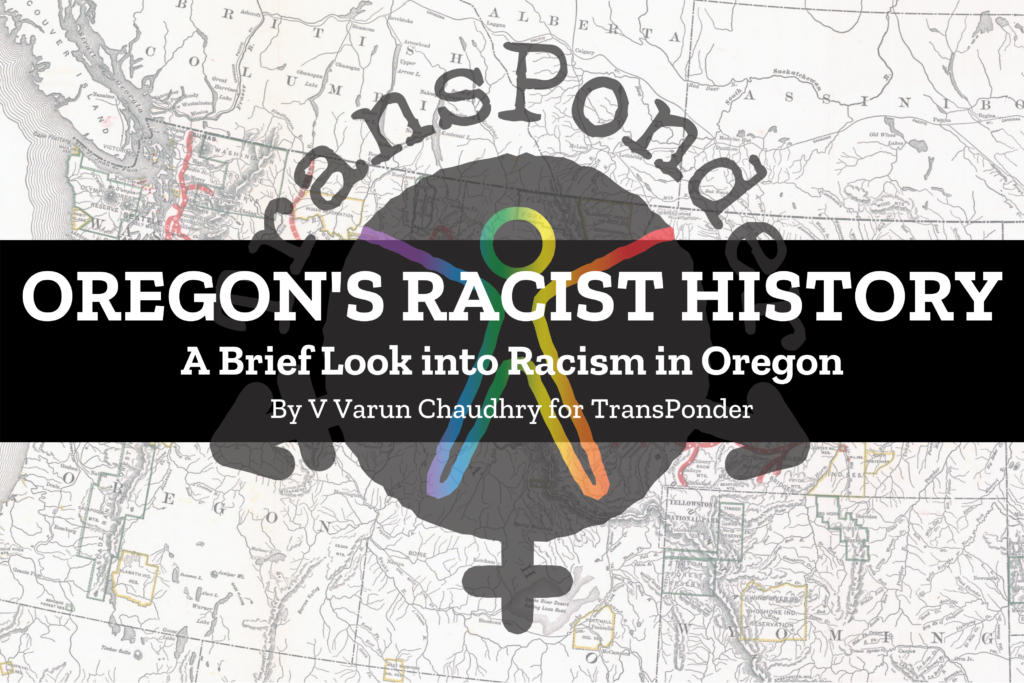Oregon’s Racial History Brief

The state of Oregon has a complicated and fraught history of racialized exclusion and violence that bears noting for Transponder as an organization committed to intersectional gender justice. “Intersectionality” is a term developed by black feminist legal scholar Kimberlé Crenshaw to describe the illegibility of black women in legal discourses about “race” and “gender.” For Crenshaw, the “intersection” provided a metaphor to think through how black women are caught between how courts could understand racial and gender discrimination: when we talk about “intersectional gender justice,” we are recognizing the interconnectedness of “race” and “gender” for all people, especially black trans folx, black women (trans-identified and not), and other people of color. In Oregon, it is important to note that “people of color” is a particularly fraught category: while Latinx communities have been a part of Oregon’s population since the 1500s (Garcia 2019) and Asians are one of the fastest-growing groups in the state (Ma 2017), black and indigenous populations have been subjected to exclusion and racialized violence since Oregon’s settlement as a state.
In the early 1800s, white migrants began to settle in what was, at that point, indigenous territory. Despite that indigenous communities had occupied that land for thousands of years prior, white migrants built towns and claimed land, forcibly displacing indigenous communities from over 2.5 million acres of land (Long and Perce 2019). Many of white migrants-cum-settlers were opposed to the Transatlantic Slave Trade, which was alive and well in the 1840s when they settled the state of Oregon; they did not, however, want to live among free (or, it seemed, any) black people, either. Early laws in the 1840s asked that any whites who had slaves were to “remove” them “out of the country” (Nokes 2018). Voters in the 1840s into the 1850s went back and forth on the specificities of the anti-black laws on the books. In 1844, voters passed a law whereby any free black person who “refused to leave” the state would be “subject to lashing” (Nokes 2018); while this law was soon revoked, another law was passed in 1849 that claimed “It shall not be lawful for any negro or mulatto to enter into, or reside” in the state of Oregon. Finally in 1857, when the Oregon State Constitution was formally ratified and enacted, delegates included an “exclusion” clause against black people, which the predominantly white residents of the newly formed state of Oregon approved by a wide margin, despite that the majority of voters voted against legalized slavery.
The laws set in the Oregon State Constitution made Oregon unique, in that it was the only “free” state (where slavery was abolished) to formally exclude black people. The state of Oregon, given the active displacement of indigenous peoples and the legalized exclusion of black people, was thus founded as a state where white people could live freely amongst themselves, free from any reminders of the injustices and inequalities that structure the United States as a nation, and certainly Oregon as a state within the U.S. The anti-black exclusion laws were not formally repealed until 1926 (nearly fifty years after slavery was legally abolished on a national level), and racist language remained in the state constitution until the early 2000s. Oregon’s black population, today, remains small, sitting at less than 2%. Oregon’s white population, by contrast, is nearly 85%. Founded as a site of white freedom, then, Oregon’s history – which continues to have legacies in the present-day, as Portland continues patterns of gentrification and displacement (Semuels 2016) and white nationalist groups are ever-present in Eugene (Crombie and Kavanaugh 2017) – demonstrates its persistence as a site of racialized exclusion and violence.
Works Cited/Further Resources
- https://americanstudies.yale.edu/sites/default/files/files/Keyword%20Coalition_Readings.pdf
- https://oregonencyclopedia.org/articles/urban_indians/#.XZTZhOdKi9Y
- https://www.oregonlive.com/data/2017/06/asians_fastest_growing.html
- https://www.oregonlive.com/pacific-northwest-news/2017/12/post_292.html
- https://www.theatlantic.com/business/archive/2016/07/racist-history-portland/492035/
- https://oregonencyclopedia.org/articles/hispanics_in_oregon/#.XZS2bOdKi9Y
- https://www.eugeneweekly.com/2018/11/21/fighting-racism/
- https://ohs.org/events/oregons-enigmatic-black-history.cfm
- https://oregonencyclopedia.org/articles/exclusion_laws/#.XZTZV-dKi9Y
- https://www.southeastexaminer.com/2015/10/displacement-of-natives-part-of-oregons-history/
Social Media Campaign
In response to the Black Lives Matter movement of March 2020, with the help of this information from V Varun Chaudhry, TransPonder’s social media team created Oregon’s Racist History: A Brief Look Into Racism in Oregon, a social media campaign which was shared July 22-29, 2020 on our social media channels: https://transponder.community/tbipoc/oregons-racial-history-brief/oregons-racist-history-social-media-campaign/
About the Author
V Varun Chaudhry is a scholar, advocate, and consultant/trainer of racial and gender justice. He is currently a faculty member in the Women’s, Gender, and Sexuality Studies department at Brandeis University, where he teaches courses in and conducts research on Transgender Studies, Queer Studies, and Feminist Research Methods.
vchaudhry@brandeis.edu
